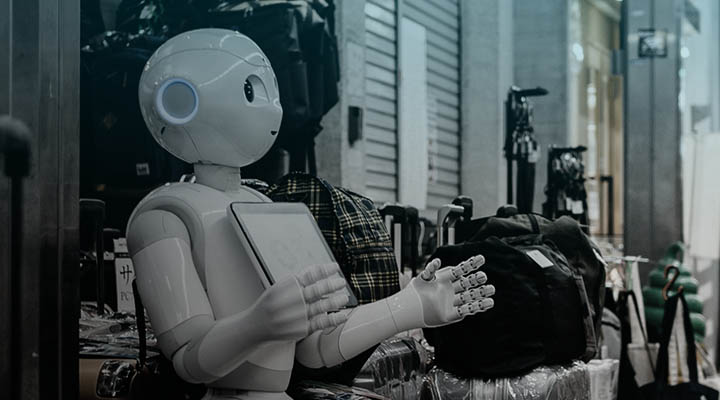Retailers must consider AI without losing sight of their number one priority - the customer. They should only implement it if it truly enhances the customer experience. Two of the hottest topics within retail in 2019 have been sustainability and new technology, with a focus on the emergence of artificial intelligence. A massive 77% of major retailers are looking to deploy the technology by 2021. However, what few people are discussing is the intersection between these two emerging trends, and whether these frontiers for change can coexist, or if there is a trade-off that firms need to make between advanced technology and sustainability.
A Happy Marriage?
On the face of it, the two seem to go hand in hand. One of AI’s most popular use cases across the business world is in forecasting. From financial services forecasting to weather predictions, machine learning is being used to improve our predictions of the future, and the same is no different in retail. Grocers, for instance, used to make an educated guess as to how much of each product to stock. With AI, they can better predict the inventory required, using the technology’s ability to consider all manner of different factors. From each product’s carbon footprint to when each product is likely to be bought and much more.
Of course, this isn’t perfect. At no point in the near future will a machine predict precisely how many people are going to go into a specific shop and buy a banana on any given day. With AI in place, firms will seek to reduce this residual loss between the expected and actual goods sold. This, in theory, should reduce the number of unsold perishable items (which also includes products such as clothes, which may become unfashionable or inappropriate), while ensuring fewer customers have the negative experience of seeking an out-of-stock item, improving both customer experience and sustainability.
Last year, Walmart unveiled it’s ‘Eden’ stock management system, which uses a ‘freshness algorithm’ and machine learning to ensure the right goods are moved to the right shop at the right time. This ensures waste is minimised, and consumers can have greater access to fresh products - a clear example of where customers and the environment can benefit from such a system, as well as the retailer. The real value lies in where companies can demonstrate this dual improvement to consumers, and tap into the ever-growing market of millennials.
AI as a Cross-Industry Solution
The use of AI in forecasting is not just on the rise in the food industry. The fashion industry is also using AI’s forecasting abilities to predict trends in a sector where some companies’ attitudes towards waste products have hit the headlines in recent times. The likes of Burberry infamously burned excess stocks to restrict the supply of their most desired products to maintain their high prices and status as a luxury brand, in one of the most extreme examples of the negative impacts of inaccurate forecasting. However, after burning an astonishing £28.6 million worth of unsold products in their last year of this practice, they have recently decided to end this highly criticised practice in a move welcomed across the industry. The announcement even gained some wider acknowledgement with Greenpeace who labelled it a much-needed sign of a change of mind in the fashion industry.
Burberry is also one of the companies pioneering the use of AI within the fashion industry, and since 2006, has aimed to reinvent itself as an “end-to-end digital business”, with the help of big data and AI. If Burberry can direct this focus on better forecasting, then it can maintain a supply which is simultaneously exclusive enough to support the brand image and sufficient enough to generate revenue for the company. This is just one example of a scenario in which AI can be used to improve the company’s bottom line as well as pleasing customers and environmental activists alike.
The Advent of Price Discrimination
Forecasting is not the only way in which fashion companies are implementing AI in the quest for efficiency gains. Algorithmic pricing is becoming commonplace, particularly for online retailers. For example, yield management has been prevalent since the beginning of the 21st century, as airlines and other fixed stock retailers aim to maximise their prices while still selling all their stock, as firms seek to price discriminate and charge the maximum amount that each customer is willing to pay. This uses an algorithm which considers several different factors such as the time until a flight and how many seats are remaining. It is undoubtedly a matter of time until other retailers take this approach, and while the first movers will likely receive backlash, the increased revenue will surely sway companies towards this approach. Gartner Inc. believes that this transition could occur by as early as 2025, estimating that 90% of firms will have planned to use AI in this way by 2021.
One only must look at limited releases of items such as Nike and Adidas trainers, which are often listed on resale sites at upwards of ten times face value just after release. The sneaker resale market is quoted at being worth $1 billion worldwide, a number which will surely lead to the original sneaker designers being interested in an AI-led pricing system in an attempt to price goods closer to their market value. Even if they remained intentionally below market value to retain the hype that surrounds the launch of certain models and not harm their accessibility to less well-off customers, there still appears to be room for manoeuvre.
Through these uses of AI, firms can better understand the interactions between supply, demand and price. By examining these more carefully, and at smaller time intervals, retailers can accurately marry supply and demand at a price that is closer to the market-clearing rate at any one time. This should lead to a reduction in waste goods, as well as ensuring continued customer satisfaction through reduced instances of out of stock goods.
From Price Discrimination to Personalisation
This personalisation does not need to stop at what different people are offered. Retailers can also utilise AI to improve their choice architecture and alter how they present various promotions and products to different customers, such as personalising what time of day and through what media a specific customer is offered a promotion. This could even stretch to how many choices are presented to each customer and what information is provided about each product, based on previous data and customer preferences.
When looking further into the future, there are many other exciting ways in which AI can develop this personalised customer experience. Nestlé has pivoted towards AI-driven personalised output, selling off their American sweets section and piloting the Nestlé Wellness Ambassador program in Japan, where members of the scheme can upload photographs of their food, from which AI will recommend lifestyle changes and personalised supplements. This could be expanded to nudge customers towards more sustainable food sources in the near future, in yet another way that AI could help decrease consumers’ environmental impact.
It is not hard to envisage a future in which you could walk into a shoe store, log into your account on a touchpad and be greeted with lights behind specific shoes that AI predicts you would be interested in, based on your past purchases and other factors. Bringing this personalisation, which can already be found in many online stores that recommend products based on what you have added to your basket, into the physical store is yet another way to improve customer interaction in this ever more experience led industry.
Not all plain sailing
One thing outside of sustainability that retailers must also be extremely prudent on is ensuring that no discriminatory algorithmic bias is present in their artificial intelligence. As this technology makes decisions based on its past experiences, retailers must ensure that the training of the AI is not completed with bias data to avoid any form of discriminatory personalised pricing. Retailers must avoid at all costs a situation where one group of people is charged more based on race, gender or sexuality, as has occurred for the likes of Amazon, who’s recruitment AI favoured male candidates as they formed a more significant proportion of the historical data. It is these unintended, unforeseen consequences of new technology which could prove most challenging for firms, and retailers must avoid any scenario like this which could alienate swathes of their consumer base and at worst lead to legal proceedings.
Additionally, the dawn of artificial intelligence is not all good news in the quest for a sustainable future, and the enormous environmental cost of running machine learning algorithms must be considered. One estimate puts the carbon footprint required to train one AI at 284 tonnes of carbon dioxide emissions. Contrasting this with the lifetime carbon footprint of a cotton t-shirt, which Ecotricity put at roughly 9kg of CO2. If a hypothetical t-shirt company was to train just one AI for use in its production process, it would have approximately the equivalent emissions of 31,500 t-shirts. That’s a staggering number, and unless it can be decreased to a more acceptable level, either through a more efficient algorithm or through energy that has come from renewable sources, this technology may only be beneficial for the largest firms from a sustainability point of view.
It is also worth noting that with the decreasing fortunes of physical stores, many of which are even less au fait with technology than their online competitors, retailers will likely wait for specific uses of AI to be proven successes within their industry before incorporating them into their business. It is this risk aversion and hesitation that could prove disastrous for some retailers in the current climate, as they must play catch up with those who have disrupted their market and seized the first-mover advantage.
If businesses can find smaller AI projects which demonstrate to them the positive capabilities of this type of technology both from a customer experience and sustainability point of view, while not disrupting their core business plan, then progress is likely to be made. Retailers must consider AI without losing sight of their number one priority - the customer. They should only implement it if it truly enhances the customer experience. As the brilliant Steve Jobs once said; “You’ve got to start with the customer experience and work back toward the technology, not the other way around”. Once retailers and customers feel comfortable with AI as a concept and have the structure in place to harness its power sustainably, then they can start to reap the rewards of this new and exciting technology.
Published
April 29, 2024Reading time
6 minutesRelated posts





